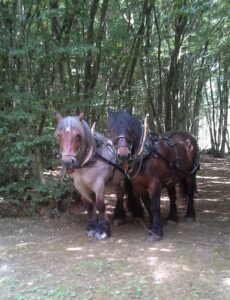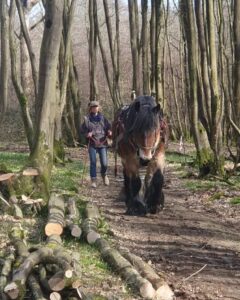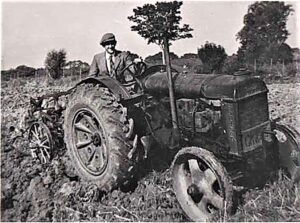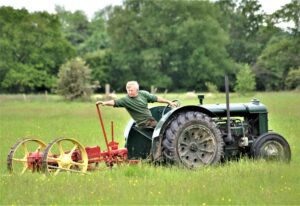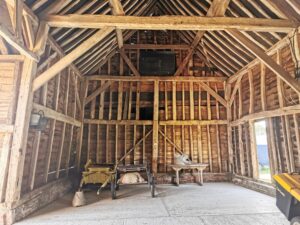The Brown Thread: Why Heritage Matters on Screen and Off
When “green” is the colour of healthy growth, regeneration, and eco-forward thinking, then “brown” is its steady, grounded counterpart — the heritage, history, and preservation that quietly hold it all together.
At Farm Locations, we often celebrate the fresh, wild and flourishing. But just as crucial to sustain is the other side of the story: the spaces that have stood still. The farms that haven’t been rewilded or reinvented, but simply respected and preserved.
This is the custodianship of the “brown.” Of heritage. Of memory. And of landowners who are choosing to hold on — and, in doing so, giving the film industry a lifeline.
Here are just a few of the farms we work with that embody this spirit — places where history is still being lived, not just remembered, and where every field, building and tool has a story to tell.
Draft Horse Farm, where woodland management traditions prevail
Frankie, custodian of Draft Horse Farm in Kent, is a passionate steward of tradition. Alongside preserving simple farm buildings and original interiors, she also keeps alive the traditional craft of horse-drawn woodland management — working in harmony with nature, just as generations did before.
“We believe in the wood, the whole wood and nothing but the wood. We understand that for a woodland to fulfil and maintain its natural and productive potential, it should be managed to the benefit of its biodiverse structure.”
Frankie has spent years researching her craft and has published a broad range of research articles and material for woodland books and journals over the years. As she puts it, “my roots are in the woods”.
Her farm is a living, breathing archive of slower rhythms and time-honoured skills.
From working props to living traditions, this is a place where the past is not only remembered but actively lived and shared. For productions seeking a big step back in time in a working woodland and farm, Frankie is providing something very special.
Pond Farm, where family history is key
Lizzie, the owner of Pond Farm near Maidstone in Kent, is a farmer, an animal rescuer and a heritage hero. She’s surrounded by vintage machinery, family history, and the legacy of her great-grandfather with his ancient tractors and implements still being used today. The farm is open to the community on certain days, with Lizzie determined to help families get closer to the land and appreciate their food better.
As she puts it:
“Continuing to have a few historic tools and some machinery in use saves knowledge from being lost and keeps a connection, not only with the people that have held and used those very same things in years gone by, but also with the surrounding environment. It keeps your fingers in the earth.”
This isn’t nostalgia for nostalgia’s sake. It’s about keeping a direct, tangible connection to the work, the skills, and the lives that shaped the farm. Lizzie says she’s “a sentimental creature” and believes that being able to hold a few things dear, and share them, “makes the hardships and toil, the passions, the dreams, the heartaches and joys of those who have gone before us, worthwhile.”
It’s a world of hay bales and hand-me-downs at Pond Fram, of old dwellings and weather-worn outbuildings. And it’s exactly this lived-in, layered texture, run by Lizzie and her menagerie of animals, that’s made it a favourite of ours to help sustain.
Three Ways Farm, a preserved farmstead like no other
Three Ways Farm near Gloucester is a story of quiet preservation. Handed down from an uncle to three siblings, this organic family farm hasn’t been overhauled or commercialised. Instead, it’s been gently maintained with the same structures, landscape and ethos as before.
As the family explains:
“Three Ways Farm is a collection of houses and buildings built over different periods that have come together as a much-loved farm and family home. Our family has been connected to Three Ways Farm since the 1890s, and during that time, very little has changed. The buildings still have cobbled floors and a drinking system which was installed when the buildings were built in the 1800s at the start of the agricultural revolution – it was designed around the central fold yard for the farmer and was all about food production for the people who owned and lived on the estate. We were born while our parents lived on this farm and it is how we have always known it and although slightly modernised over time, eg. A milking parlour installed in the old cart shed, mains water introduced for the milking in the late 60s, structurally it is the same and holds so many happy memories.”
From cobbled floors to the original Victorian drinking system for livestock, and long-hidden beams to fireplaces uncovered during restoration, the farm’s history is woven into every corner. The family describes the feeling here as “a step back in time… a peacefulness too often missing from modern life.”
For filmmakers, that authenticity is priceless. For the family, hosting productions is a way to fund the maintenance and restoration, without losing its soul.
Cherry Farm, the icing on the heritage cake
Cherry Farm in Hertfordshire, is home to a new generation of the farming family. Vicky is leading the charge to preserve the farm once cut through by the M25.
“Cherry Farm, with its most venerable buildings originating in the 15th century, has seen the constant cycle of tilling, sowing, growth and harvest since at least the late medieval period, and very likely long before. It has been the home of many families before my own arrived in the last century, all of whom left their mark on the land. Another barn here, a newly enclosed field there, perhaps a new porch on the farmhouse. Each farmer and their families left a piece of themselves in this place, until it steadily morphed into its current form, like a great living thing.”
She’s bravely opted not to modernise, or convert into holiday lets or turn into commercial rentals. She’s chosen a route loyal to her ancestors, more true to her role as a custodian for future generations: to preserve the land and buildings as they are, and let film, TV and photoshoot productions be the sustainable income stream that supports it.
“The buildings of Cherry Farm bear the marks of a hundred skilled carpenters and plasterers, and its pastures and woods teem with life after the stewardship of many centuries. Although there may be farms like it in England, perhaps just as old and beautiful, this one is ours (for a century or two at least)…its survival is miraculous, and its spirit is vibrant and alive.”
Horses may still graze the fields, and tractors still work to cut the hay, but this is a place of pause — of buildings kept just as they’ve always been. Its period simplicity is its magic.
Let’s Help Preserve What’s Real
We often talk about sustainability in terms of innovation, that is, being more efficient or creating new things. But sometimes sustainability lives in the spaces we choose not to change.
These landowners aren’t clinging to the past – they’re carefully preserving the present, so the future can access it too. They are respectful to the hard work and crafting that has gone before them, and are doing their best to pass them on again, intact and thriving.
For the world of filmmaking, these places offer more than just another location. They offer a genuine depth of truth, texture and narrative to their film or image. The kind of depth that can’t be fabricated – can only be found. But they’re getting harder and harder to find.
In a world where most routes of farm diversification ask landowners to build, modernise or adapt, this is one of the rare income streams that doesn’t. It’s a form of support that works with what’s already there and asks very little in return.
We’d love to see more of the industry step up to recognise that. To choose these places. Champion them. And to help ensure they have a future. Because if we don’t, these rare and rugged gems risk fading away. And once they’re gone, they can’t come back.
For now, we’ll keep doing what we can: telling their stories, opening the gates, and matching them with productions that see their worth. But if you’re part of the creative industry, we’d love your help.

